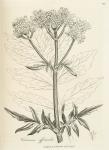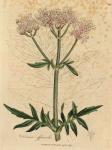
 Synonyma. Valeriana svlvestris. Pharm. Lond. & Edinb.
Synonyma. Valeriana svlvestris. Pharm. Lond. & Edinb.
Valeriana sylvestris major. Bauh. Pin. p. 164. Gerard. Emac. p. 1075. Park. Theat. p. 122. Raii Hist. p. 388. Synop. p. 200.
Valeriana foliis pinnatis, pinnis dentatis. Hal. Hist. Stirp. Helv. n. 210.
Valeriana officinalis. Hudson. Flor. Ang. p. 12. Withering. Bot. Arr. p. 36. Flor. Dan. p. 570.
α Foliis angustioribus.
Class Triandria. Ord. Monogynia. Lin. Gen. Plant. 44.
Ess. Gen. Ch. Cal. o. Cor. 1-petala, basi hinc gibba, supera. Sem. 1.
Spec. Char. V. floribus triandris, foliis omnibus pinnatis.
The root is perennial, consisting of a great number of simple fibres, which unite at their origin: the stalk is upright, smooth, channelled, round, branched, and rises from two to four feet in height: the leaves on the stem are placed in pairs upon short broad sheathes; they are composed of several lance-shaped, partially dentated, veined, smooth pinnae, with an odd one at the end, which is the largerst: the radical leaves are larger, stand upon long footstalks, and the pinnae are elliptical, and deeply serrated: the floral leaves are spear-shaped and pointed: the flowers are small, of a white or purplish colour, and terminate the stem and branches in large bunches: there is no calyx, or only a small narrow rim: the corolla consists of a narrow tube, somewhat swelled on the under side, and divided at the limb into five obtuse segments: the three filaments are tapering, longer than the corolla, and furnished with round antherae: the germen is placed beneath the corolla, and supports a slender style, shorter than the filaments, and terminated by a thick bearded stigma: the capsule is crowned with a radiated feather, and contains one seed of an oblong shape. It flowers in June, and commonly grows about hedges and woods.
The narrower-leaved variety of this species of Valerian, which does not exceed two feet in height, and affects dry heaths and high pastures, is justly in more repute than the other; its roots manifest stronger sensible qualities, and consequently possess more medicinal power; their smell is strong, and has been compared to that of a mixture of aromatics with fetids; their taste unpleasantly warm, bitterish, and subacrid. "The powdered root, infused in water or digested in rectified spirit, impregnates both menstrua strongly with its smell and taste. Water distilled from it smells considerably of the root, but no essential oil separates, though several pounds be submitted to the operation at once." [Lewis, M. M.]
Valerian is supposed to be the (greek) of Dioscorides and Galen [Graecis (greek) esse credo, a (greek) abominantis: olet enim radix felinum quid, non tamen sine grato odore nardi Hoff. "This smell is highly delightful to cats; rats are also said to be equally fond of these roots, and that rat-catchers employ them to draw the rats together." Withering. l. c.], by whom it is mentioned as an aromatic and diuretic: it was first brought into estimation in convulsive affections by Fabius Columna, [Phytobasamos Neapol. 1592. p. 97.] who relates that he cured himself of an epilepsy by the root of this plant; we are told however, that Columna suffered a relapse of the disorder, and no further accounts of the efficacy of Valerian in epilepsy followed till those published by Dominicus Panarolus [Iatrologism. s. medicin. hist. pentac. quinque Rom. 1643. Pentec. i, Obs. 33. p. 20.] fifty years afterwards, in which three cases of its success are given. To these may be added many other instances of the good effects of Valerian root in this disease, since published by Cruger, [Eph. Nat. Cur. Dec. 2. A. 7. Obs. 78.] Schuchmann, [Eph. Nat. Cur. Dec. 2. A. 4. Obs. 44. p. 116. & App. ad Dec. 3. A. 3. p. 86.] Riverius, [Prax. Med. Lib. i. p. 62.] Sylvius, [Opera, p. 427.] Marchant, [Mem. de L'Acad. d. Sc. de Paris, 1706. p. 333.] Chomel, [Pl. Usuelles. T. i. p. 228.] Sauvages, [Nosol. Method. T. iii. P. 2. p. 231. Ed. 8vo.] Tissot, [Traité de l'epilepsie, p. 310.] and others.
The advantages said to be derived from this root in epilepsy caused it to be tried in several other complaints termed nervous, particularly those produced by increased mobility and irritability of the nervous system, in which it has been found highly serviceable. [Haller says, "Ego certe ad hystericos morbos, nimiamque nervorum sensibilitatem, frequenter cum bono eventu hac radice usus sum; et in ipsa epilepsia, non malo successu. Stirp. Helv. n. 210.] Bergius [Mat. Med. p. 30.] states its virtus to be antispasmodic, diaphoretic, emmenagogue, diuretic, antihelminthic. [He says, "Emeticam illam nunquam vidi, nec laxantem." The latter quality is however very generally ascribed to it by medical writers.] Under the head usus he enumerates Epilepsia, Convulsiones, Hysteria, Hemicrania, [Fordyce commends it highly in this disease, De Hemicrania, p. 91. Whytt, who joined it with manna, experienced its utility in epilepsy, On Nerv. Dis. p. 513. Joined with guaiacum, Morgan found it useful in resolving glandular or strumous humours. Phil, princ. p. 424.] Visus hebetudo. Dr. Cullen says, "its antispasmodic powers are very well established, and I trust to many of the reports that have been given of its efficacy; and if it has sometimes failed, I have just now accounted for it, [From the disease depending upon different causes, and from the root being frequently employed in an improper condition.] adding only this, that it seems to me, in almost all cases, it should be given in larger doses than is commonly done. On this footing, I have frequently found it useful in epileptic, hysteric, and other spasmodic affections." [Mat. Med. vol. ii. p. 372.] It is said however, that in some cases of epilepsy at the Edinburgh Dispensary, it was given to the extent of two ounces a day without effect; [New Ed. Dispens. by Dr. Duncan, p. 300.] and our own experience warrants us in saying, that it will be seldom found to answer the expectations of the prescriber. The root, in substance, is most effectual, and is usually given in powder from a scruple to a dram: its unpleasant flavour may be concealed by a small addition of mace. A tincture of Valerian in proof spirit, and in volatile spirit, are ordered in the London Pharmacopoeia.

